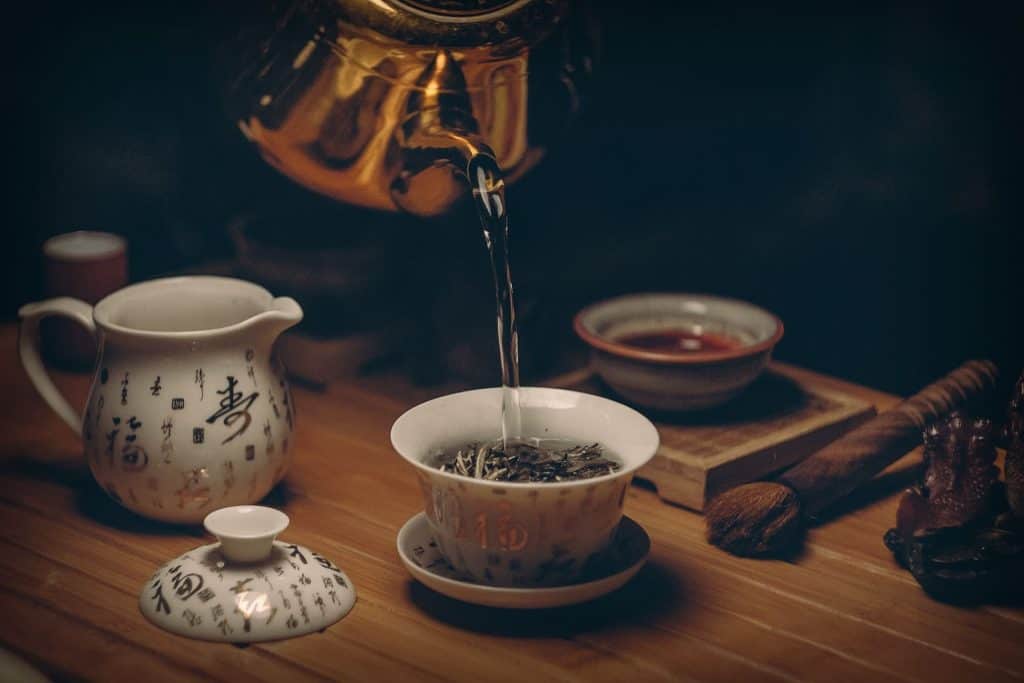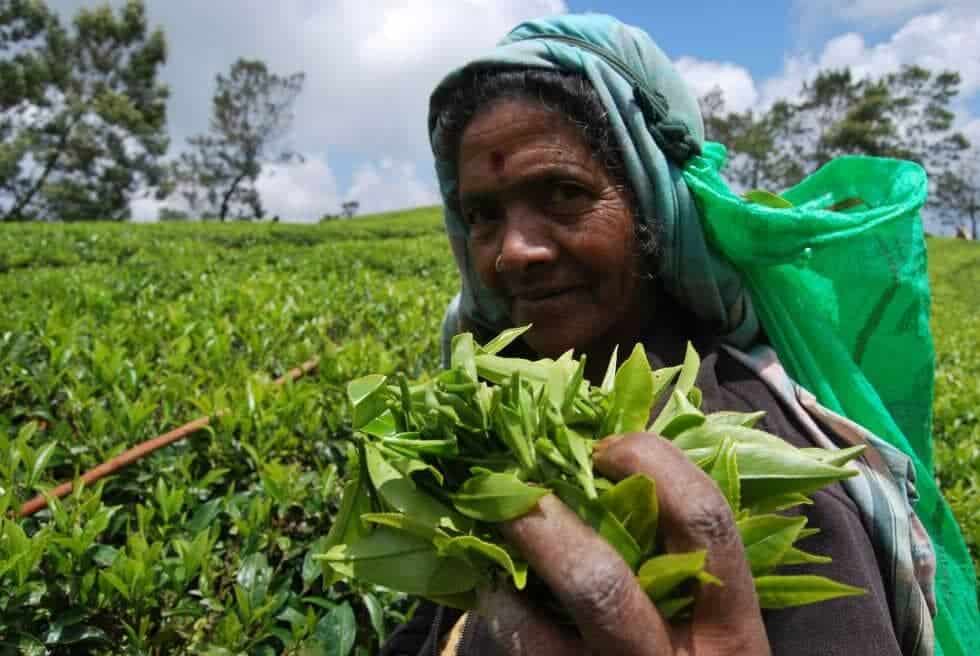
Chinese tea is an infusion of tea plant leaves (Camellia Sinensis) and boiled water. The Chinese were the first to collect tea leaves to prepare this famous drink. In Asian cultures, tea is a drink that can be drunk at any time, even to accompany chinese meals.
History of Chinese tea 🍵
According to Chinese legend, it is said that it was Emperor Sheng Nung who discovered tea in 2737 BC.
“The emperor was sleeping under a bush while a saucepan of water was boiling next to him. Then, a few of the leaves of the shrub fell into the water and Sheng Nung drank the mixture, feeling much better to drink it.“
In the Han Dynasty, the techniques of collecting and making tea were improved and it became popular among the nobles as a drink and not as medicine, which had been their role until then.

At the time of the Wei and Jin dynasties, tea was preferred over wine in meetings, in order to obtain a calm climate that would give rise to interesting conversations. Thanks to the wars, the custom of drinking tea spread from Sichuan to the Yangtze River. The rest of the social classes also began to drink it.
During the Tang dynasty, Lu Yu made a compilation of the wisdom of his ancestors about tea in a book called “Tea Classic“. Tea rooms emerged and local shops were also served by their shopkeepers.

Thanks to the Silk Road, Chinese tea reached the rest of Asia. The Buddhist monks, on the other hand, took it to Japan. The first Europeans to try tea were the Portuguese, who traded it from Macao.
In the 17th century, the Dutch East India Company exported tea to Europeans, including the English, who became the Europeans who consumed the most Chinese tea. So much so that they adopted it as a reference of their country. Later, they created tea with English milk.
Chinese tea benefits and properties 🍃
Chinese tea leaves have multiple properties and benefits. And although they differ greatly depending on the type of tea and the region (which we will talk about later), they all have distinctive shared characteristics.
- Reduces “bad cholesterol” in the body
- Regulates blood glucose, thus controlling diabetes
- Works as an antioxidant, preventing aging
- Prevents the onset of heart disease
- Improves oral hygiene
- Helps reduce body weight and fat
Types of Chinese tea 🍂
You don’t know which one to take? I introduce you to all types of Chinese tea and the medicinal properties of all types of Chinese teas.
Green tea: It is the most used in China. Its leaves hardly suffer oxidation in its processing. It is antioxidant, anticarcinogenic and prevents cardiovascular diseases.
It has a bitter taste. There are many variations of green tea such as Matcha tea, Pi Lo Chung tea and Anhui Emerald tea.
It is known to be a great medicinal chinese tea, perfect for preventing aging, cancer and heart disease.
Yellow tea: Although its oxidation is the same as that of white tea or green tea, the oxidation in this case is slowed down with dry heat. To make it, some stems are also used. Its color is yellowish.
Red Tea: It is the most used Chinese tea in the West. It is a tea highly oxidized in barrels, so the leaves acquire their red color. Unlike green tea, it keeps well for several years. It is good for the stomach and is a diuretic.
It also has a lot of theine. This tea cultivated mainly in the Chinese province of Yunnan. In Russia and Europe it is in great demand.
Blue tea: Better known as oolong tea. It is a semi-oxidized tea that comes from Fujian, Canton or Taiwan. It is good for slimming, wrinkles and allergic skin reactions.
Black tea: It is the one that has more oxidation and also the one that has more theine. It is consumed mainly in southern China. There are many varieties of black tea. The best known is Pu’er tea, originally from the province of Yunnan.
Pu’er tea may have been fermented from 2 to 60 years! It is good for weight loss and cholesterol. Due to its oxidation presents a dark color.
White tea: It is slightly oxidized in its processing (10-30%). The youngest leaves are used to make it. Although it is similar to green tea and some people consider it to be green tea, it actually has more antioxidants than green tea.
So it is even more effective against aging. In addition, its taste is less bitter and more delicate. It is only grown in China, mainly in Fujian province.
Lesser-known types of teas
To the following teas with different oxidations can be added other herbs, flowers or roots, which enhances their medicinal properties and improves their taste. These are the most famous
Jasmine tea: It is usually made with green tea or white tea. It is the most famous scented tea in China for its taste with a sweet and subtle touch. It is good for relieving stress, headaches and muscle aches.

Ginger Tea: It is anti-inflammatory, good for slimming and relieving nausea. Also good for the stomach, cough or as an expectorant. It is usually added to red tea or green tea. It has an acidic and spicy taste.
Longjing Tea: Also called Dragon Well tea. It is a type of green tea grown in the coastal province of Zhejiang.
Mao Feng Tea: Another green tea from Anhui province. It is cultivated in the yellow mountain of Huangshan. Its name in Chinese means “Skin of the summit”.
The tea ceremony 🍵
The tea ceremony is a ritual concerning the preparation of tea. It is practiced in several Asian countries such as India, Korea, Japan and China. But also in African countries such as Morocco, and in some European countries such as England.
In China, tea ceremonies began to emerge from the eighth century, as it began to be used as a refined drink by the upper classes. Before that it was only considered a medicine.
To carry it out correctly, three teapots have to be used. One to heat the water, another to infuse the tea leaves, and the last one to serve the tea.

Natural water should be used and heated between 75 and 85 degrees, never more than 85 degrees, as the tea would lose its properties. The glasses and the teapot must be heated beforehand so that the tea does not cool down.
Afterwards, the person in charge of the ceremony serves the Chinese tea glasses (which do not have handles) in half. The other half has to be filled with positivity and respect.
Then, the participants drink from them by holding it with their thumb and index finger, and their middle finger under the glass. If they want more tea, it can only be served by the person in charge of the ceremony. One should never serve oneself.
Chinese Tea Nomenclature 💮
Tea in Chinese is pronounced “Chá” and is written with this character: 茶
The lower part of the character is 木 , which means tree, shrub or wood. The upper part is ⺾, which means grass or leaves. Finally, 人 is in the middle, which means human.
Therefore, it can refer to a person collecting the leaves of the tea bush.

Tea export in East Asia 🍃
Since ancient times tea has been produced in Asian countries and exported to other continents. However, tea crops spread to other continents of the world, although most Chinese tea is produced by the Asian continent.
Depending on the type of tea, the plantation is more favorable to one climate or another, so the production and export of tea can be classified according to type.
In addition, Chinese tea is a product rooted in global consumption habits, making it a very important product for the Asian economy today. But it has also been in antiquity because of its high international demand.
The export of tea in China
Tea is a national product of China. Due to its domestic consumption, only a part of the tea produced in China is exported, because of that, India is the world’s leading tea exporter.

Most of the tea that China produces is destined for domestic consumption because it is processed in a traditional way and is of high quality, making it more expensive than tea produced in India and Sri Lanka for brands such as Twinning.
In the West, since there is no tradition of tea as a culture, it is not important how it is processed and the lowest price is sought. But in China quality and culture are sought, so traditionally processed tea is often sold more expensive.
Chinese tea is produced mainly in the following regions: Jiangbei, Jiangnan, South China, and Southwest China.
Other tea exporting countries
The largest tea-exporting countries are as follows: Sri Lanka, which exports 22% of the world’s tea, China, Kenya, India, the United Arab Emirates, Germany and Poland.

Sri Lanka, China and India are the three major tea exporters, with all three countries earning more than several million dollars a year from annual tea exports.
Tea importing countries 🍵
As for the demand for tea, the countries that most demand tea are: Russia, United Kingdom, Afghanistan, USA, Pakistan, Egypt and Kenya. The countries that import the most tea, therefore, are European and African.
Russia is the largest importer of Chinese tea, importing up to 180 tons per year, exceeding 40 tons of tea to the United Kingdom, so it is the country that imports more tea by far.

World’s Leading Chinese Tea Companies 🍃
- Zhejiang Tea Group: It is the largest exporter of tea from China and the largest exporter of green tea in the world. It was founded in 1950 and is headquartered in Hangzhou. It has offices in Japan, Mali, Morocco, Pakistan and Togo. To preserve Chinese tradition, this group integrates traditional techniques with modern techniques, and is working on new products.
- Hunnan Tea Group: It is the Chinese company that exports the most tea to the United States and the one that exports the most tea from Hunnan companies. It is the second company in the Chinese tea industry and the first company to export organic tea in China.
- Fujian Tea Company: Founded in 1950, this company is engaged in foreign tea trade. It mainly exports white tea, jasmine tea, black tea, and oolong tea. They have tea processing factories in Fuzhou and Fuxing, which lead the automatic production of oolong tea and jasmine tea.
Buy Chinese Tea at Amazon 💰
If you are wondering where to buy Chinese tea, Amazon usually sell tea bags of many types at good prices. Highly recommended.

